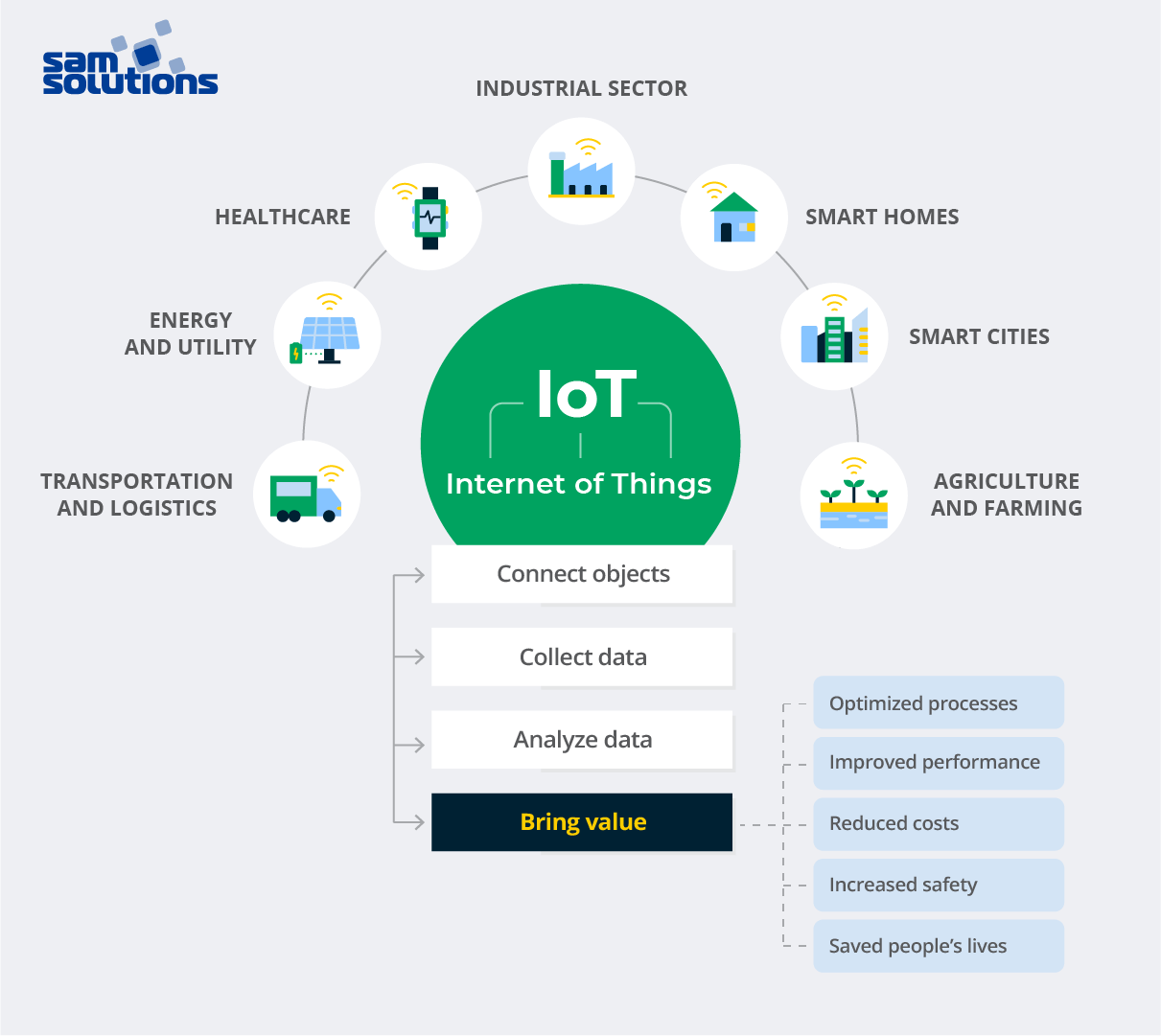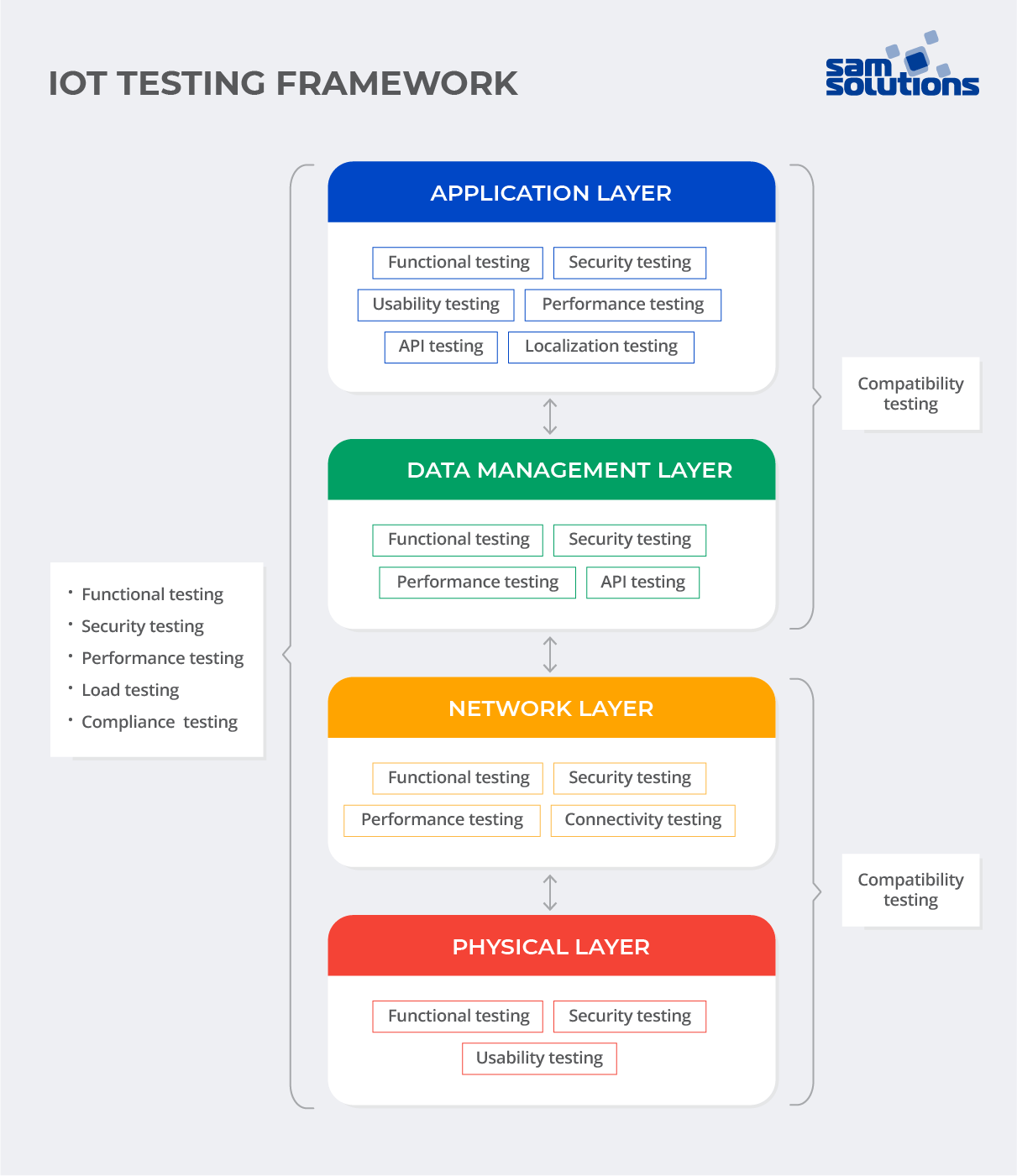As a provider of IoT solutions with extensive experience, we recognize the significance of testing for ensuring the proper operation of connected assets. We wrote this article with the aim to tell you more about IoT testing best practices and for you to better understand what tests you need to conduct in order to quickly bring your IoT solutions to the market.
Leverage the latest IoT technologies with our expert team and get powerful IoT solution for your business.
What Is the Internet of Things?
Since IoT technology has penetrated literally all spheres of our life, many people are by now familiar with the concept and can give a standard definition, such as “IoT is about connecting things or objects to the internet.”

Let’s write a clear, concise but comprehensive definition of Internet of Things by looking at specific use cases and answering these three questions: What? How? Why?
1. WHAT solutions are used in practice?
IoT solutions are used across numerous industries:
- Location, inventory, warehouse tracking systems in transportation and logistics
- Resource monitoring and optimization systems in the energy and utility industry
- Real-time health monitoring systems in healthcare
- Monitoring of the production process and machinery operating conditions in the industrial sector
- Remote control of domestic appliances in smart homes
- Automated urban services in smart cities
- Weather conditions monitoring and animal tracking systems in agriculture and farming
2. HOW is it implemented?
The operation of IoT solutions is based on
- various IoT devices (GPS trackers, sensors, smart locks, etc.) with embedded software
- data collection technologies such as RFID (Radio Frequency Identification) tags
- networks, such as NFC (Near-Field Communication) or LAN (Local Area Network)
- protocols and connectivity options (Bluetooth, ZigBee, MQTT protocol)
- monitoring platforms
- data analytics platforms (e.g., Microsoft Azure IoT Hub).
3. WHY is it needed?
The ultimate goal of developing IoT solutions is to bring value for people with the help of collected information, i.e.:
- optimize processes
- improve performance
- reduce costs and consumption of resources
- increase safety
- save people’s lives.
We can now write the definition of IoT.
Internet of Things is the technology that allows you to connect any object (living and non-living, stationary and moving) from any industry or sphere of life to the internet with the help of sensors, devices, and connectivity methods in order to collect and analyze data and thus bring value to its users.
What Is IoT Testing?
In the software development cycle, testing plays a crucial role. As an integral part of quality assurance (QA) services, it ensures that the final product meets all customer demands and properly operates in given conditions.
IoT testing is the practice of checking whether IoT devices comply with specified requirements and operate as required in the field.
The peculiarity of IoT testing is that you have to check the compliance of both software constituents and physical devices.
Why is testing needed? In a nutshell, it helps you reduce the time and costs of project modifications and improvements, allowing you to go to market first.
IoT Testing Approaches
To ensure the high quality of IoT products and services, you should develop a thoroughly planned strategy and choose the most efficient IoT testing tools.
The general infrastructure of IoT systems comprises four layers:
- Physical layer — sensors, controllers, other connected devices that collect data
- Network layer — gateways, communication units that ensure connectivity and data transmission
- Data management layer — local or cloud centers (or backend) that provide data storage, aggregation and analysis
- Application layer — software for user interaction (or frontend) that provides reporting and control capabilities
That’s why, due to the complexity of such solutions, there are several approaches to IoT testing.
- Check all layers separately.
- Check the interoperability of several layers.
- Check the operation of the entire system.
One of the best practices is to create an IoT testing framework so that you can visualize the required test cases and arrange the process. For example, all layers should first be checked for security and functioning separately, and then as an entire system; the application and data management layers need API to be checked; the physical and network layers should be checked for compatibility; and so on.
Take a look at the example of such framework below.

Types of IoT Testing
Let’s now look at the most popular types of testing that ensure the stable operation of IoT devices.
Functional
Functional tests aim to simulate the operation of separate components or the entire system under real-life conditions to make sure that they perform the required functions properly. Such tests are applicable to devices, gateways, networks, data centers, software applications.
Performance
The goal of this testing is to check whether the system or components meet the specified key performance indicators (KPIs) such as speed or responsiveness under normal operating conditions. Performance testing is an obligatory step before scaling an IoT solution to production.
Load
If performance testing is conducted under normal conditions, load testing aims to check the system’s scalability at the extremes. By examining load capacity, you push an IoT system beyond its capacity and check how well it operates at maximum scale. This helps you find out, for example, whether it can process an increasingly large amount of data without compromising connectivity, accuracy and response time.
Usability
The ultimate goal of usability testing is to identify how convenient, intuitive and attractive the product is for end users. A number of users corresponding to a set of criteria (age, gender, profession, etc.) are needed to participate in this type of testing in order to avoid subjectivity and get relevant feedback. This helps you obtain relevant feedback on the usage of your product, and detect and eliminate any shortcomings.
Security
For Internet of Things, security comes first. Why? The operation of IoT solutions is based on data exchange and processing. In most cases, this is personal or business-critical data that requires a high level of protection. Security concerns may be located across the entire IoT environment. That’s why security testing should be applicable to all levels of an Internet of Things system (devices, networks, cloud platforms, data centers, user apps).
Compatibility
Due to the multi-layered structure of IoT systems, compatibility testing is required to check the operability of possible combinations of devices, protocols, operating systems, software versions, etc.
Connectivity
In the Internet of Things, components must be able to interact with each other. That’s why it’s essential to verify various communication methods, as well as information exchange between IoT devices and users. While connectivity testing, you should consider the environment in which the device will be used (network type, signal strength, weather conditions, etc.) and verify how it will function under the given conditions.
Other
A range of other checks can be performed depending on the solution. For instance, compliance testing is needed to check whether the software meets local or international norms and standards; API testing checks the performance and security of application programming interfaces; localization testing may be needed to check the solution’s compliance with regional or cultural peculiarities.
IoT Testing Challenges
- Integrated approach. IoT testing is a challenging process primarily because it’s not only about IoT software testing: you need to check a mixture of hardware and software components and ensure that they work as a coherent system. Hardware devices, gateways, on-prem or cloud servers, networks, protocols, analytics platforms — these and many more constituents from different vendors should communicate with each other so that the solution performs its intended function.
- Too many possible combinations. For some solutions, it’s hard or even impossible to check all the potential working variants, because there are too many hardware and software components on the market.
- Security and privacy. Connectivity to the network always means vulnerability to data leakage and hacking attacks, which makes security control for the Internet of Things highly challenging.
IoT Testing Tools
Test automation is undoubtedly the best practice in Internet of Things development. So, you need automated IoT testing tools for software and hardware. Following is a list of IoT testing tools you may use.
- Simulators — create test environments for thousands of devices and sensors, supporting numerous Internet of Things protocols. Example: SimpleIoTSimulator.
- Network analyzers — monitor traffic and resolve network issues. Example: Wireshark, Tcpdump.
- Hardware debuggers — monitor hardware parameters such as signal integrity, power outages, etc. Example: JTAG.
- Security testing tools — monitor configurations of IoT devices to detect security breaches. Example: AWS IoT Device Defender.
- Compatibility testing tools — ensure that devices and software versions are compatible. Example: ICAT.
Don’t Hesitate, Test It
While developing Internet of Things solutions, we recommend you do not cut corners on testing. An elaborate testing strategy is the only way to:
- bring endless components of IoT systems together
- provide an exceptional user experience
- accelerate time to market.
Specialists at SaM Solutions are ready to help!



















 The Latest 15 Information Technology Trends in 2024
The Latest 15 Information Technology Trends in 2024 Top 10 Embedded Software Development Tools
Top 10 Embedded Software Development Tools IaaS vs. PaaS vs. SaaS: What’s the Difference?
IaaS vs. PaaS vs. SaaS: What’s the Difference? 10 Examples of Predictive Analytics
10 Examples of Predictive Analytics












 Web App Development Cost in 2025 [Key Price Factors]
Web App Development Cost in 2025 [Key Price Factors] 13 Best React Development Tools in 2025
13 Best React Development Tools in 2025 Top 10 Mobile App Development Trends 2025
Top 10 Mobile App Development Trends 2025 Top IoT Industry Trends in 2025
Top IoT Industry Trends in 2025 Java Web App Security: Everything You Need to Know
Java Web App Security: Everything You Need to Know
Great reading about the importance of Iot and it’s testing.
Many modern IoT solutions are enormously complicated, they may comprise thousands of devices and connectivity touchpoints. That’s why IoT providers should pay special attention to testing. Thank you for discussing this urgent topic.
This article provides clear and concise information on IoT testing, its importance, types, approaches, and tools.
I like the way you present information in your articles. This is much appreciated and helpful, thanks a lot!
There are so many types of tests needed to properly check an IoT system, you definitely need experienced and reliable testers and QA specialists.
Testing for Internet of Things systems is a must, I agree. Without appropriate testing, you can never achieve the required functioning of connected devices because there are too many challenges and conditions to be met.